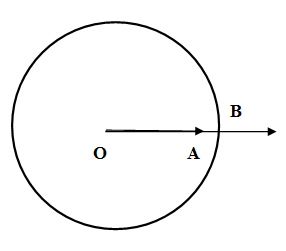
An angle which measure ${{0}^{\circ }}$ is called,\[\]
A. obtuse \[\]
B. acute angle \[\]
C. zero angle \[\]
D. right angle\[\]
Answer
559.5k+ views
Hint: We recall the definition of angle, measure of an angle as the amount of turn by one ray to coincide another. We recall the definition of degree as a unit of measure of angle and find the relation between degree and turn to choose the correct option for ${{0}^{\circ }}$. \[\]
Complete step by step answer:
We know that angle is a figure formed in the plane by two rays having a common point. The common point is called vertex of the angle and the rays are called sides. If $\overrightarrow{OA},\overrightarrow{OB}$ be two rays that form an angle with vertex O then the angle is denoted $\angle AOB$ whose rough figure is drawn below.\[\]

We know that the measure of an angle is the amount of rotation or turn from one ray to another. It is measured as the ratio of length of a circular arc centred at the vertex and bounded by two rays. The measure of angle $\angle AOB$ is amount of turn $\overrightarrow{OB}$ has to complete to coincide with $\overrightarrow{OA}$ or the amount of turn $\overrightarrow{OA}$ has to complete to coincide with $\overrightarrow{OB}$. It is denoted by $m\angle AOB$ or simply $\angle AOB$.
We know that one of the unit of measure of angle is degree. A circle is divided into 360 parts and ${{1}^{\circ }}$ is the amount of turn for ray to cover $\dfrac{1}{360}$ parts of the circle. An angle of measure ${{\theta }^{\circ }}$ is an angle that covers $\theta \times \dfrac{1}{360}=\dfrac{\theta }{360}$ parts of the circle is drawn below. \[\]

If the ray will not turn at all the points $A,B$ will lie in the same line and will cover $\dfrac{0}{360}$ parts of the circle and hence the measure of the angle is ${{0}^{\circ }}$. This angle is also known as zero angle. \[\]

So, the correct answer is “Option C”.
Note: We note that if the ray covers ${{\left( \dfrac{1}{4} \right)}^{\text{th}}}$ or quarter of the circle then the angle is called right angle whose measure is ${{360}^{\circ }}\times \dfrac{1}{4}={{90}^{\circ }}$. If ray rotates for ${{\left( \dfrac{1}{2} \right)}^{\text{th}}}$ or half of the circle the angle is called straight angle whose measure is ${{360}^{\circ }}\times \dfrac{1}{2}={{180}^{\circ }}$ If the ray rotates less than quarter of the circle the angle is called with measure less than ${{90}^{\circ }}$ and if the ray rotates more than quarter of the circle but less than half of the circle the angle it is called obtuse angle whose measure is more ${{90}^{\circ }}$ and less than ${{180}^{\circ }}$.
Complete step by step answer:
We know that angle is a figure formed in the plane by two rays having a common point. The common point is called vertex of the angle and the rays are called sides. If $\overrightarrow{OA},\overrightarrow{OB}$ be two rays that form an angle with vertex O then the angle is denoted $\angle AOB$ whose rough figure is drawn below.\[\]

We know that the measure of an angle is the amount of rotation or turn from one ray to another. It is measured as the ratio of length of a circular arc centred at the vertex and bounded by two rays. The measure of angle $\angle AOB$ is amount of turn $\overrightarrow{OB}$ has to complete to coincide with $\overrightarrow{OA}$ or the amount of turn $\overrightarrow{OA}$ has to complete to coincide with $\overrightarrow{OB}$. It is denoted by $m\angle AOB$ or simply $\angle AOB$.
We know that one of the unit of measure of angle is degree. A circle is divided into 360 parts and ${{1}^{\circ }}$ is the amount of turn for ray to cover $\dfrac{1}{360}$ parts of the circle. An angle of measure ${{\theta }^{\circ }}$ is an angle that covers $\theta \times \dfrac{1}{360}=\dfrac{\theta }{360}$ parts of the circle is drawn below. \[\]

If the ray will not turn at all the points $A,B$ will lie in the same line and will cover $\dfrac{0}{360}$ parts of the circle and hence the measure of the angle is ${{0}^{\circ }}$. This angle is also known as zero angle. \[\]

So, the correct answer is “Option C”.
Note: We note that if the ray covers ${{\left( \dfrac{1}{4} \right)}^{\text{th}}}$ or quarter of the circle then the angle is called right angle whose measure is ${{360}^{\circ }}\times \dfrac{1}{4}={{90}^{\circ }}$. If ray rotates for ${{\left( \dfrac{1}{2} \right)}^{\text{th}}}$ or half of the circle the angle is called straight angle whose measure is ${{360}^{\circ }}\times \dfrac{1}{2}={{180}^{\circ }}$ If the ray rotates less than quarter of the circle the angle is called with measure less than ${{90}^{\circ }}$ and if the ray rotates more than quarter of the circle but less than half of the circle the angle it is called obtuse angle whose measure is more ${{90}^{\circ }}$ and less than ${{180}^{\circ }}$.
Recently Updated Pages
Master Class 9 Social Science: Engaging Questions & Answers for Success

Master Class 9 Science: Engaging Questions & Answers for Success

Master Class 9 English: Engaging Questions & Answers for Success

Master Class 9 Maths: Engaging Questions & Answers for Success

Master Class 9 General Knowledge: Engaging Questions & Answers for Success

Class 9 Question and Answer - Your Ultimate Solutions Guide

Trending doubts
Which places in India experience sunrise first and class 9 social science CBSE

Fill the blanks with the suitable prepositions 1 The class 9 english CBSE

Write the 6 fundamental rights of India and explain in detail

Difference Between Plant Cell and Animal Cell

What is pollution? How many types of pollution? Define it

What is the Full Form of ISI and RAW




